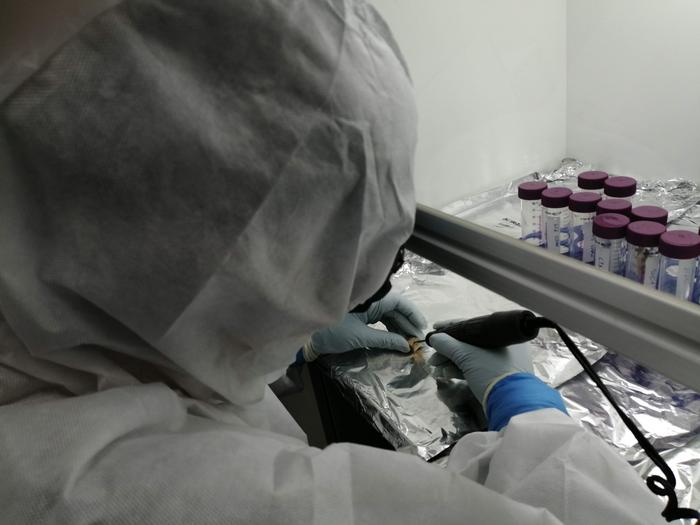In a groundbreaking study that sheds new light on the social dynamics of the world’s earliest farming communities, researchers from Durham and Liverpool Universities have uncovered remarkable insights into Neolithic mobility patterns through the chemical analysis of ancient teeth. This investigation, involving 71 individuals from five archaeological sites in modern-day Syria, spans an extensive time frame from 11,600 to 7,500 years ago, illuminating how early humans interacted, migrated, and integrated within nascent village societies.
Utilizing the precise scientific method of strontium and oxygen isotope analysis, researchers meticulously examined tooth enamel to trace geographical origins. Teeth preserve unique isotopic signatures that reflect the environmental conditions where individuals grew up, enabling scientists to distinguish locals from migrants with exceptional accuracy. This powerful biomolecular approach reconstructs movement patterns previously invisible in the archaeological record, transforming our understanding of human habitation and connection in the Neolithic era.
The findings reveal a compelling narrative of village life in the Northern Levant, an important corridor for agricultural expansion. Once permanent settlements were established, most people exhibited strong local ties, opting to remain within their communities rather than migrate. However, this pattern was nuanced by a discernible trend in which women were more mobile than men during the late Neolithic period. Such sex-biased mobility aligns with the concept of patrilocality, where men typically stay in their birth village, and women move to their husband’s community, a behavior that likely served to promote genetic diversity and avoid inbreeding.
Intriguingly, isotopic data combined with archaeological evidence such as skeletal remains and funerary patterns paint a rich picture of social cohesion. Both local inhabitants and newcomers were often interred together with indistinguishable burial rites, indicating social inclusion and equal regard for individuals regardless of origin. This challenges earlier assumptions that early villages may have been insular or exclusionary, instead suggesting an openness to assimilation and integration of migrants into shared social and spiritual life.
One of the most striking sites, Tell Halula, revealed house floors layered with human remains from multiple generations. Detailed analysis demonstrated that those buried together, including both locals and non-locals, received consistent funerary treatments such as specific body positions and elaborate grave goods. This uniformity underscores a form of social solidarity that transcended geographical origins, hinting at a complex societal structure where community membership was not solely determined by birthplace.
The study advances scientific frontiers by emphasizing the multi-disciplinary synergy between isotope geochemistry, bioarchaeology, and cultural anthropology. By pairing chemical signatures with artifact analysis and burial customs, the research team could reconstruct the intimate social fabric of early agricultural societies, unveiling patterns of kinship, marriage, and mobility driving community dynamics. Such comprehensive methodologies exemplify how modern science can reinterpret millennia-old questions about human social evolution.
Senior researcher Dr. Eva Fernandez-Dominguez highlights the novelty of this integrative approach, remarking on its unprecedented ability to reveal the nuanced balance between rootedness and movement in the Neolithic. The research dispels simplistic views and underscores the vitality of newcomers in shaping villages, as individuals from afar were not marginal outsiders but key participants enriching communal life, customs, and innovation.
Moreover, the work spotlights women’s roles as principal agents of mobility and cultural transmission. Dr. Jo-Hannah Plug from the University of Oxford stresses that female movement networks were likely pivotal in fostering regional interactions, facilitating the circulation of technologies, ideas, and genetic material across considerable distances. This discovery reframes women’s contributions to early societal development as central rather than peripheral processes.
The implications of these findings extend beyond archaeology into broader discourses regarding human social behavior, migration, and community resilience. The early farmers exemplified a blend of stability and connectivity that supported population growth and cultural complexity. Understanding their adaptive strategies enriches our knowledge of how humans negotiate identity and belonging within evolving social landscapes.
Furthermore, the evidence that immigrants were accorded equivalent funerary honors reveals early expressions of social equality and inclusiveness. Such practices may have functioned to integrate diverse individuals and mitigate conflicts, fostering social cohesion critical for the survival of early complex societies. This underscores the idea that early agriculturalists consciously cultivated inclusive communities despite physical mobility and cultural diversity.
The research exemplifies how cutting-edge isotope geochemistry continues to revolutionize archaeology, offering precise tools to map ancient human life histories. It also fills a vital geographical gap in the Northern Levant region—an area crucial for understanding the origins and spread of settled farming life, yet previously underexplored in bioarchaeological studies.
Funded by The Leverhulme Trust, this seminal research sets the foundation for future explorations into prehistoric mobility, social networks, and cultural transformations. As analytical technologies advance and interdisciplinary collaborations deepen, the nuanced stories of humanity’s earliest villagers will become increasingly accessible, presenting ever richer narratives of our shared past.
Overall, this detailed isotopic and archaeological investigation into Neolithic teeth presents a vibrant image of early village societies as dynamic, inclusive, and interconnected communities. Women’s mobility, social integration of migrants, and shared funerary practices emerge as hallmarks revealing the intricate social fabric from which modern humanity’s agricultural foundations were woven.
Subject of Research:
Neolithic human mobility and social integration revealed through strontium and oxygen isotope analysis of tooth enamel.
Article Title:
Strontium and oxygen isotope analysis reveals changing connections to place and group membership in the world’s earliest village societies.
News Publication Date:
3 October 2025
Web References:
http://dx.doi.org/10.1038/s41598-025-18134-3
Image Credits:
Credit: Dr. Eva Fernandez-Dominguez
Keywords:
Neolithic, isotope analysis, tooth enamel, strontium isotopes, oxygen isotopes, mobility, patrilocality, social integration, funerary practices, early farming communities, Northern Levant, archaeology, bioarchaeology




